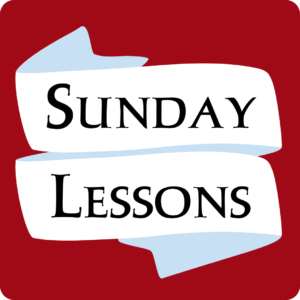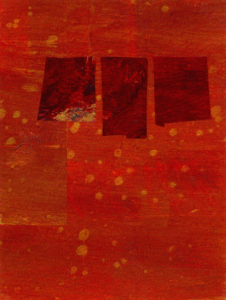Worship Guide for May 25, 2025
Like TV Guide, but from God! Find the text of the Prayers of the People and Sermon below. Use the buttons provided to find other worship materials.
To see the Worship Guide for other weeks, click here.
To see the Book of Common Prayer online, click here.
Prayers
Prayers of the People:
Memorial Sunday, 25 May 2025
The response to the bidding, “Lord of peace and security,” is “hear us”
Lord, in a time of increasing threat of violence at home and war abroad, make us instruments of the coming of your peace with justice among us. Lord of peace and security, hear us.
On this Memorial Day Weekend, we pray for the men and women of our armed services who may be called upon to pay the ultimate price of life in defense of our freedom. We mourn all who have lost their lives in past and present wars. We will remember them. Lord of peace and security, hear us.
In a time when violent words fan violent actions, we pray for the Congress and the courts to uphold the integrity of the Constitution and the rule of law. Lord of peace and security, hear us.
We pray for the Church and her life: Sean, Presiding Bishop, and for Nicholas, our bishop; for Hosam, the Archbishop of Jerusalem; for Pope Leo; for Bartholomew, the Ecumenical Patriarch; and all Christian leaders as together we face the growing insecurity of a deteriorating world rules-based order. Lord of peace and security, hear us.
We pray for the world and its pressing needs: Forgive our silent enabling of the monstrous military violence being unleashed upon the helpless people of Gaza. We decry the use of food, water, and medicines as instruments of war. With growing concern, we remember the Palestinian communities of the West Bank being subjected to the violence of ethnic cleansing. We urgently pray for peace with justice to come to the Middle East.
We continue to pray for a negotiated peace in Ukraine that honors a commitment to Ukrainian sovereignty and future self-determination.
We pray for an end to the civil wars in Sudan, Yemen, and Myanmar. For all forced to flee from their homes and homelands by the violence of war and threats to life and livelihood. Lord of peace and security, hear us.
We remember the earth, our increasingly fragile island home. We pray for the strengthening of emergency services and necessary infrastructure to meet the challenge of climate instability. We remember communities devastated by the recent tornadoes sweeping the South and Midwest. Lord of peace and security, hear us.
We pray for all in need and in trouble: for those whose strength is failing through ill health; whose spirits are flagging through depression; whose determination is being sapped through addiction; that they might know our comforting presence and healing. Lord of peace and security, hear us.
We remember with love those who have asked for our solidarity in prayer: Mary, Sam, Benjamin, Katharine, Stefan, Aiden and Payton, and others we name. Lord of peace and security, hear us.
We pray for our own needs, together with those nearest and dearest to us, remembering especially those celebrating birthdays this week: Tony Cottone, Kathy Good, Tom Barr, Dianna Lima, Joshua Lacey, and Jane Taylor. Lord of peace and security, hear us.
Celebrant adds a concluding prayer.
God of the living and the dead, united in so great a cloud of witnesses: You have reminded us that there is no greater love than to lay down our lives for those we love. Guide with your wisdom those who take counsel for the nations of the earth, that in tranquility and peace your dominion may increase until the world is suffused with the power of your love, Lord of peace and security, hear us.
Sermon
Resurrection is a Communal Project
K Casenhiser
Sixth Sunday of Easter
Year C
In the name of God, made known to us and through us as the Lover, the Beloved, and the Love-Sharer. Amen.
Today, we find ourselves on the sixth Sunday after Easter, feeling the great fifty-day feast of Eastertide Resurrection press towards its culmination in Pentecost. As Linda noted in her sermon yesterday, Easter is still with us and within us. My friends, we are the body of Christ. This means that resurrection is not a spectator trip; it’s a communal project, a pneumatological gift, enacted by the Spirit. “Do not let your hearts be troubled,” Christ says to his friends. These ancient words of comfort remind us that the project of resurrection endures even when the winds of change howl, and we can no longer cling to familiar comforts or each other as we once did. This week’s Gospel lesson, set firmly inside the farewell discourses in John, considers what resurrection requires of us after everything changes again. It highlights the relationship God sustains with us so that we can be faithful to this communal project of making the kingdom of life known among us—the project of making heaven known as a place on earth, as Mark envisioned. Resurrection continues because God sends the Advocate, the Holy Spirit, and the Paraclete to remain with the disciples and bear peace through them and us.
Eastertide is a time well-versed in profound shifts from presence to absence, betrayal in the royal courtyards to reconciliation over breakfast on the beach, from death to life after it. In each of these post-resurrection vignettes, we are invited to perceive resurrected life through the eyes of Jesus’ heart, as Linda noted. Jesus spends his time after the crucifixion, carefully, persistently preparing his friends for his second absence. This one is stranger and more permanent than death. Here in these vignettes, we encounter Christ tilling the soil of the disciples ’ spirits for another exit, which will complicate their grief and call them deeper into a work of ministry, marked by the companionship and empowerment of the Holy Spirit. Considering this context, doesn’t it make sense that Judas (not Iscariot) asked, “How will you be known to us when you are gone?” Isn’t this simply Thomas’s inquiry transposed: How will I know it is you among us, Jesus? Indeed, this is the question of this hinge moment: what makes Christ recognizable among us in life that carries with it memories of death, loss, and the possibility of future endings? Jesus takes goodbyes seriously because when things end, things change. Old forms of relationships fall away, and new forms emerge, and those new forms of relationship are a gift.
So then, before we rush into Pentecost, let us pause and ask: What kind of farewell does Jesus demonstrate? And what might we glean from it as we consider the transitions before us? Endings are painful partings and mercies that bind. But endings can also strengthen our bonds if we accept farewells as legitimate closures. Only then can we determine how endings open up new spaces where new relationships can flourish. In this way, Jesus’ ascension, his departure, wasn’t about leaving the disciples—or us—bereft. No, it was a deliberate act of divine creativity: making space for new forms of relatedness in the wake. Jesus steps away in one form so that a new, boundless, more expansive Divine Presence could rush in—a Presence ignited by his Spirit, accessible not just to a few, but to all. Jesus returns to God, the Father, so that, through the gift of the Holy Spirit, we can return to union with God and one another.
This week, the Gospel cadence from John, from Jesus’ tender farewell discourses, invites us to lean in close. What does this resurrected life truly demand of us, in the deepest parts of who we are? Eastertide itself, this fifty-day wonder, is a dance of profound inversions, isn’t it? From the ache of presence lost to the surprise of absence filled. From the chill of betrayal in a shadowed courtyard to the warmth of reconciliation over breakfast by a forgiving sea. From the stark silence of death to the whispered melodies of life reborn. In those sacred moments after the cross, Jesus, with such painstaking love, prepared his dearest friends for his next leaving–a–departure even deeper, more mystically permanent than death. He was tending the soil of their spirits, nurturing them for a ministry still to unfold, one that would be lit by the Spirit’s unwavering companionship and quiet strength.
Imagine: the tangible Presence with which the disciples were so familiar in one person, Rabbi Jesus, their teacher, in one particular place and time, was once again about to burst from its familiar confines to transform into something else. In the ascension, God’s Presence will be radically reconfigured again in the moment just before that happens. So again, here is Jesus with his disciples and his friends, preparing them to ascertain that in his physical absence, through the Spirit, they would become what they had received: peace. In Christ’s ascension, we are commissioned to become the peace we have received from Christ. They, and we, his followers across time, are called to be His living, breathing Body in a world longing for an experience of heavenly communion on earth. Therefore, departure is not about retreat. Instead, it is about divine action that forges peace within us and between us. By sending the Advocate, God ushers in, yet again, a new way for God to relate to humanity, and for us to find God in each other, through the Spirit. The resurrection project is a communal one, and it pivots on the Spirit.
This profound shift in divine presence, from the particular physical body of Christ to the spiritual that permeates all bodies, is a movement from the singular to the collective. This movement naturally raises questions. We hear an echo of our hearts in the disciple Judas (not Iscariot), who, as theologian Andrew McGowan reminds us, was essentially asking Jesus, ‘Lord, how is it that you will reveal yourself to us?”
Jesus’ answer then, and now, reframes our expectations. He doesn’t promise a public spectacle. Instead, he speaks of love, faithfulness, and the practice of peace: “Those who love me will keep my word, and my Father will love them, and we will come to them and make our home with them.” Divine revelation, it turns out, is not a spectacle, but a humble practice of peacemaking. The project of resurrection enacts a shared community life where, through the love we bear for one another by keeping the word of Love, Christ will be recognizable among us.
Peace is at the core of this relationship forged in the wake of anticipated endings, and this peace is not only a gift but a promise. This peace is our call and our blessed assurance because, as the passage from Revelation imagines, this peace born from life amid death is future-oriented.
So far, receiving the gift of peace that binds and hopes in endings sounds good. Yet this peace arrives with a caveat: “My peace I give to you. Not as the world gives.” In a world like ours, this May of 2025, still reeling from political storms, exhausted by headlines that screech with heedless conflict, how could they—how can we—easily grasp the distinction between Christ’s peace and the peace the world fabricates? Too often, the world’s peace is maintained by force, scapegoating, and expulsion of the ‘other.’ This peace is not a mercy, a gift sustained through a relationship. We see it in our public square, where settling the argument trumps staying with it until we find common ground, where a momentary ceasefire in partisan battles is mistaken for genuine reconciliation. Perceiving God’s peace requires “Easter eyes”—a transformed vision that sees beyond black and white possibilities and persists in the promise of lasting union with God and one another, not only in some far-off utopic heaven, but on earth. Christ ascends to the Father, and the Holy Spirit, the Advocate, descends to be among us in the square where life and death meet.
What do these Easter eyes perceive, especially in our politically charged, fiercely polarized landscape? Even when the Beloved departs, the Beloved is still recognizable to us through the gift of peace. When Jesus says to his friends, “Do not let your hearts be troubled, and do not be afraid,” it’s not a suggestion but a loving and firm declarative statement, a direct command. Peace is the language that makes God understandable to us and people understandable to each other. Peace is the way we are called to travel in the wake. And those who receive this peace must accept Christ’s farewell to fully participate in a love that God longs to keep enacting and widening on earth. This practice of love, which brings him peace, is now the way Jesus shows himself to the world.
Considering how we might act as peace-bearers in these days where countless terrors lurk, I, like many of you, have not been able to dislodge the image of the late Pope Francis’s last public outing from my mind. Sensing death’s nearness, on Easter Sunday, he asked his nurse to bring him back to St. Peter’s Square, to be in his Popemobile among the people. From that square, he offered his Easter Blessing, calling for a ceasefire in the Holy Land, for justice in our relations, and the courage to disarm ourselves of our defenses and instead “revive our trust in others, including those who are different than ourselves.” For the late Pope Francis, peace-making is the project of resurrection. As our passage from Revelation indicates, peaceful streets where heaven and earth are again one is the future to which we must continue to aspire.
As I anticipate my goodbye to this place of nurture and solidarity, and search for the courage to step into the great unknown once again, Pope Francis’s final act—turning back to the square to be among friends and strangers, old and new, rather than inward to the familiar—gives me courage. He answered the Spirit’s call to be Christ’s peacemaking body. His last public words were to his nurse: “Thank you for bringing me to the Square.”
It is our time to enter the square and remain with the Spirit. Now is the time to prepare for what comes after this Season of Eastertide, when Christ ascends and the Holy Spirit descends—our Comforter, our Advocate, working in and through us. What comes next? How, as Judas (not Iscariot) relatably asks, will God continue to make God’s self known to us after Easter? Jesus’ answer is our key: God will be known to us, and through us, through the action of love, which is peace. We are to be peace-bearers. The resurrection project is a peace-making endeavor, and the currency of peace-making is love. This is the Word of God we are commissioned to remember and enact. “Those who love me will keep my Word.” The Word of God is Love sustained through peace, and love cannot be accomplished alone; it is inherently a communal project. Without it, there can be no Church. Audre Lorde urged us, “We have to consciously study how to be tender with each other until it becomes a habit,” to reclaim sacred wisdom and cultivate a livable future. The resurrection project is communal, and it is a practice of making tenderness with each other habitual. This is the word and the work of the Spirit.
It’s true, the Beloved’s future absence physically leaves a void, a yearning, like all endings do. Yet, Alfred North Whitehead described God as “a tender care that nothing be lost,” so while we feel keenly how much is being lost, we also feel how close God’s invitation is. I’m reminded here of a paragraph from Barbabra Brown Taylor’s recent substack: “Some days, the most faithful thing I can do is lie face down on the earth and say, ‘Will you have me back?”… For all the places religion has taken me, it begins and ends in dirt.” The dirt, death, begets life, new forms of relationship that will welcome us if we dare to welcome as Brown says, “the beyond right in front of us” with “compost stuck to our pants cuffs, dough in our aprons, and the smell of fish on our hands… trusting the Spirit’s instinct about where the peace, the true treasure, is hidden.”
Soon, Pentecost will arrive, and with it, the birth of the Church. The traditional color of this season is the vibrant red of the Spirit’s fire, as breath and life-force. Powerfully, red is the color of birth and death. The heaven God longs for on earth will not be enacted without our willing bodies. And yes, sometimes resurrection, like birth, is messy and risky. It’s true, we often find ourselves on the birthing stool, laboring to bring forth God’s vision for heaven in the here and now. This farewell is not an abandonment, but a birth. Resurrection is a communal project. It’s a commissioning, perhaps an off-season commissioning—a time when familiar comforts dim, usual structures shift, and we are propelled forward, asking: how will the Beloved be visible now, and what is our part in it?
Jesus’s physical departure, which felt like an ending, created the sacred space for this new, diffused Presence – the Holy Spirit, the Advocate. The Spirit is the one who teaches and reminds the community, empowering them, empowering us, to live out Jesus’ words. The collective sign now powerfully demonstrates what was once revealed in one physical body. Standing together in love, the community becomes the vessel of this ongoing resurrection marked by the peace the Spirit gives.
And so, friends, when we hear John 14 today, we should understand them as words of comfort and commission. Currently, we are being summoned to participate in the communal work of resurrecting life through the power of the Holy Spirit. The living God, who is the perfect community, is making their home within the loving, word-keeping, risk-taking body – within us, when we dare to live out that audacious love. Community action is the beating heart of resurrections. Our practice of faith is recognizable through shared life where Christ’s peace and presence are not just abstract concepts, but are actively built, tenaciously woven, and experienced. When we practice peace and yield to peace-making as the work of the Spirit, heaven becomes discernible on earth. This is the sacred, joyful, and yes, sometimes challenging work to which we are called: to build this home with Christ, together. For resurrection is, and always will be, a communal project.
Amen.





